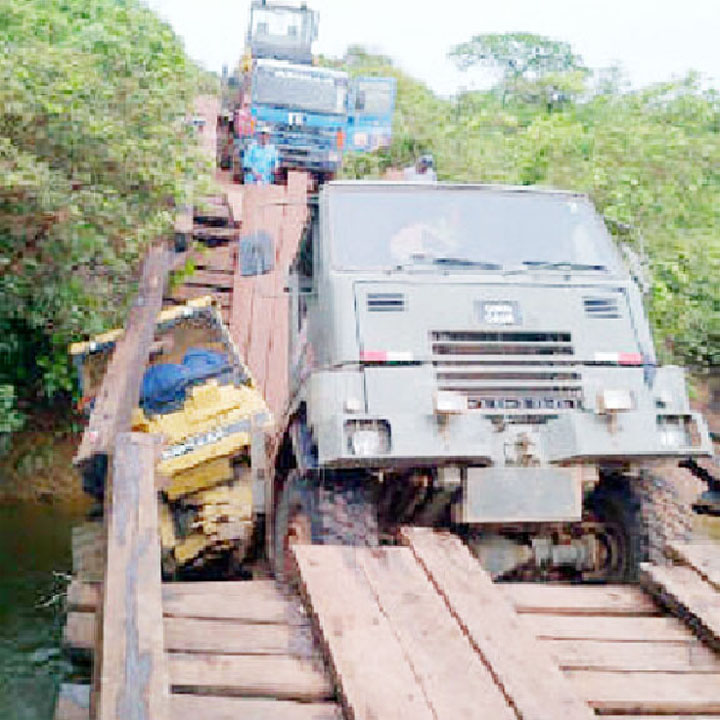Works Minister Robeson Benn says that the St Ignatius Bridge, which on May 16 gave way under the weight of a truck which was transporting an excavator, was mostly concrete, even as calls have been made for a transition from the construction of wooden bridges in Region 9 to fully concrete bridges.
Though photos taken of the bridge, as well as eyewitness descriptions suggested that the St Ignatius Bridge was mostly a wooden structure with concrete elements, Benn, when asked if a St Ignatius Bridge remade strictly in concrete would not better serve the community, said that the bridge was a concrete one.

Benn said, “The bridge is a concrete bridge, it just has a surfacing or a decking of wood, the structure which failed is concrete.”
This claim contradicts those made by Region 9 Councillor Carl Parker and a resident of the area, Mr Beckles. Beckles had indicated that though mostly wooden, the bridge was supported by concrete beams, one of which was cracked prior to the accident.
According to Benn, it was the failure of the concrete elements of the bridge which cause it to cave in.
Parker in particular, both at the time of the accident and after, criticised the state of the bridge. He classified most of the bridges in the area as “ill-constructed,” in one instance.
He said he has been advocating for the construction of concrete bridges in the area since 1998. Parker said that since then, the Regional Democratic Council (RDC) has been arguing that the construction of such bridges would be too costly and as such beyond the region’s ability to fund.
Considering this argument, Parker said that he then suggested that one concrete bridge be built per year as opposed to launching a massive transition project to convert all wooden bridge to concrete. This approach, he said, would have been far more feasible, and, if adopted would have seen most, if not all wooden bridges which exist in the area converted to concrete by now.
Asked his opinion on the assertion, Region 9 Chairman Wilson Lorentino told Stabroek News that he also believed that concrete bridges would be a better alternative to the current wooden structures. He stated however that since being elected as Regional Chairman (RC) last year he has never been approached by Parker with his suggestion. Nevertheless, he said that at a meeting held earlier this week, members had come to the consensus that concrete bridges would better serve the community, although no policy commitments have been initiated.
Not relenting on his assertions, Parker, in the May 20 edition of the Stabroek News, once again criticised the bridges in the area and added that several of these had either been washed away in floods or broken while being traversed.
In his letter Parker stated: “In 1998, while still an officer of the Regional Democratic Council, Region 9, I suggested that we build at least one concrete bridge a year.
This idea was laughed at by a then senior official. His concern at the time was if these bridges were to be built, then over time there would have been no need for the contractors and that the trade would die a natural death.”
Asked if concrete bridges would be more practical for Region 9, Local Government Minister Ganga Persaud told Stabroek News on Wednesday that he was unable to make such a pronouncement since he was no engineer. The minister, who also said he was unaware of any such calls by Parker, explained that while he may be of the opinion that concrete bridges might indeed better service the Region, he would rather have it pronounced on by an engineer, lest his renderings be discredited by subsequent professional offerings.
A well-known engineer, who asked that his name not be mentioned, said that concrete bridges were indeed better suited for the area, and added that these suggestions had been made since Anthony Xavier was the Works Minister.
The engineer shared that Xavier had been advised of the benefits of using concrete bridges as opposed to wooden ones since 1999, but said that no action was taken in this direction.
Detailing the advice, the engineer said Xavier was told that “pre-cast concrete piles, which were just as competitive but more sturdy than wooden piles, could be used as the structures’ foundation.
“Such bridges would easily stand up to rain, falling branches and brindle, and the weight of heavy machinery,” the engineer said.
“Commonsense would tell you that a concrete or even steel bridge would be better than one made of wood,” he said.







